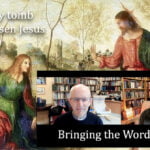The gospel lectionary reading for the Second Sunday in Epiphany is the next stage in Jesus’ initial encounter with the first disciples in John 1.43–51, in which Philip introduces Nathanael to Jesus. Like other passages in this early part of the Fourth Gospel, it is quite a sparse narrative, but laden with significance, including anticipations of the later gospel narrative, as well as including realistic geographical and temporal markers.
The shape of this encounter matches closely, in structure and language, the immediately preceding episode:
John 1.35–42 | John 1.43–51 |
| Andrew and Peter from Bethsaida | Philip from Bethsaida |
| Two disciples find and follow Jesus (one named as Andrew) | Jesus finds Philip and invites him to follow |
| Jesus says ‘Come and see’ to the two | Philip says ‘Come and see’ to Nathanael |
| Andrew says to Peter ‘We have found the Messiah’ | Philip says to Nathanael ‘We have found the Messiah’ |
| Jesus calls Simon ‘Peter’, the Rock | Jesus describes Nathanael as ‘a true Israelite’ |
The parallels and the differences will offer us some important insights into the theological dynamic at work here.
The language of ‘the next day’ is striking for two reasons. First, it offers a very specific and localised contrast with the general and cosmic language of the prologue; the One who was beyond space and time—who indeed was the source of all space and time—has ‘become flesh’ in a very particular place and at a particular time. Secondly, the progression of time markers leads up to the climactic event of the sign of water into wine at Cana, where Jesus ‘revealed his glory’ (John 2.11, using language related to ‘epiphany’). From John 1.19, John the Baptist gives his testimony and answers interrogation; in John 1.29 on ‘the next day’ (day 2) he points to Jesus as the lamb of God; in John 1.35 ‘the next day’ (day 3) he repeats his description, and the first disciples follow Jesus; here in John 1.43 ‘the next day’ (day 4) Jesus meets Nathanael. Finally, the miracle at Cana takes place ‘on the third day’, that is, on day seven, which is the end of this week of the beginning of the new creation in the ministry of Jesus.
The Fourth Gospel is careful to note geographical markers, and makes mention of more, and more detailed, place names than do the Synoptics. Jesus’ move to Galilee offers a counterpoint to John’s ministry, which we are told took place ‘in Bethany across the Jordan’ (John 1.28). Galilee and the region around Jerusalem become the two main focuses of Jesus’ ministry in this gospel, along with places on the journey between them—but this gospel’s focus is much more on Jerusalem in contrast to the focus on the ministry in Galilee in the Synoptics (thus supporting the idea that this gospel was written by a Jerusalem disciple, rather than one of the Twelve). So Jesus is recorded as visiting Jerusalem for the pilgrim festivals several times a year, as he surely must have done. And when the Twelve are sent out on mission in Mark 6.7–13, we are not told there what Jesus was doing—except John 5 tells us he was in Jerusalem. And the Galilean ministry of Mark 6.65–9.50 is summarised in a single sentence in John 7.1! (We are given the time markers in John 6.4 and 7.2, which show this was a six-month period.)
Here Jesus decides, on his own, to head to Galilee, and this accords with the Fourth Gospel’s general depiction of Jesus as acting on his own, sometimes in isolation; Mark Stibbe describes him as the archetypal lonely hero. Where in the Synoptics Jesus is most often grouped with his disciples either in distinction from the crowds or in contrast to their opponents, in the Fourth Gospel Jesus stands apart from the Twelve, who in fact have little role in the narrative, and often find Jesus puzzling, enigmatic or difficult.
Jesus finding Philip contrasts with the previous episode in which the disciples seek out Jesus. Both dynamics are true to life (in that some come to faith after seeking, others after a sense of being sought) and both occur in this gospel. Having been sought, Philip later helps others to seek (John 12.21). The invitation of Jesus to both kinds of people is ‘Come…follow me.’ There is no description in the Fourth Gospel of the calling of the Twelve, and they are mentioned without introduction or explanation (John 6.67, 70, 20.24); here as elsewhere, the writer is assuming that we are already familiar with the story, most likely from reading Mark.
‘Philip’ is a Greek name (from philos + hippos, ‘lover of horses’), as is Andrew, and Peter is the Greek version of the Aramaic Cephas, whilst Simon is a Jewish name. Although ‘salvation is from the Jews’ (John 4.22), we are already being given hints on how the good news will be translated (John 1.38) into the language, culture and context of the wider world. Having learnt here that Philip is from Bethsaida, we are told in Luke 9.10 that the Feeding of the Five Thousand takes place near there, which explains why in John 6.5 Jesus asks Greek-speaking Philip about local provision. (These ‘undesigned historical coincidences‘ help us see the different gospel traditions as integrated and interweaving.) Bethsaida is significant as being a boundary place, on the border between the jurisdictions of Herod Antipas, who executed John the Baptist, and Philip the Tetrarch; Jesus will need to escape from the one to the other in due course.
Having been sought by Jesus, Philip seeks out another; in this sense Philip is now taking the role of Jesus, but he also follows the example of Andrew, in announcing his discovery of the Messiah, ‘the one of whom Moses wrote’; the double reference to ‘the law and the prophets’ is a way of referring to all the scriptures that we find similarly deployed in Luke 24.27.
As soon as he becomes a disciple he also becomes a missionary; that is the only true discipleship (William Temple, Readings in St John’s Gospel, p 30).
Once more, we have the characteristic contrast between the cosmic and universal Word becoming the particular—he is from Nazareth, the son of Joseph. This is one of only two mentions of Jesus’ father Joseph in this gospel, which again appears to assume that we know the back story. The other, in John 6.42, highlights the problem with the contrast between the cosmic and spiritual and the local and physical, the paradox of the incarnation: “Is this not Jesus, the son of Joseph, whose father and mother we know? How can he now say, ‘I came down from heaven’?”
Nathanael, whose name means ‘given by God’, is mentioned only in this gospel. He is one of the disciples who meets Jesus whilst fishing in John 21, so there has been some speculation that this is another name for the apostle Bartholomew, mainly because neither are mentioned together, and both appear to be associated with Philip. John 21.2 tells us that Nathanael is from Cana, and this would then make sense of the sequence in John, where the wedding in Cana is the next episode.
Nathanael’s slightly scornful response to Philip ‘Can anything good come from Nazareth?’ has a proverbial ring to it, and has come into English as a kind of proverb, used about any insignificant or unexpected place. In context, this is a reasonable question; there are no records of Nazareth prior to the first century, and at the time it was a small village of no real importance. Nearby Sepphoris was much more significant, as was the lake port of Tiberias. Philip responds to Nathanael’s philosophical or theological objection with a personal, experiential invitation, ‘Come and see’, again echoing Jesus’ invitation in John 1.39. This gospel is certainly not short of theological ideas and reflection, and yet it is consistently marked by the dynamic of ‘seeing and hearing’, of people experiencing the reality of Jesus for themselves and then testifying to others what they have experienced.
If Nathanael begins his movement towards Jesus, then Jesus sees him as he begins his journey; the language of movement, of ‘coming towards’, gives this whole narrative a sense of dynamic, a reflective equivalent to the dynamic of the repeated ‘immediately’s in the opening of Mark’s gospel.
Both of Jesus’ statements about Nathanael suggest surprising insight and knowledge of him on Jesus’ part. We might speculate on how Jesus comes to know these things about Nathanael, but he has already offered insight into Simon/Peter by declaring his new name (in anticipation of the Synoptic account of this, or as a re-ordering of it?) and will in chapter 4 demonstrate supernatural knowledge of the woman by the well, and this appears to be the same kind of thing. It appears as though Jesus knows Nathanael even better than he knows himself.
The mention of ‘deceit’ (dolos) is one of several references to the Jacob/Israel narrative. Jacob is consistently depicted as lacking trust in God, and seeking to pursue his aims by means of his own guile; his name means ‘grasping’, and he steals the first-born’s blessing of his father Isaac from his brother Esau by ‘deceit’ (Gen 27.35). After battling with God at the Jabok, he is given the name ‘Israel’, which becomes the designation of God’s people—and it is to this Israel that John the Baptist testifies about Jesus (John 1.31).
The fig tree is an important symbol within the story of Israel. On the one hand, lack of figs, along with the image of the unfruitful vine, is a symbol of unfaithful Israel coming under the judgement of God (Jer 8.13, Mic 7.1) and is thus the background to the narrative of Jesus cursing the fig tree, which then withers, on his way into the (unfaithful and unfruitful) temple in Matt 21.19 (and parallels). On the other hand, a fruitful fig tree signifies both Israel’s early love for God (Hos 9.10) and therefore the hope of this renewed relationship in the eschatological age when the Messiah comes (Mic 4.4, Zech 3.10). Jesus has come, as the Anointed One, to woo Israel back to God and usher in the hoped-for new age.
What ‘greater things’ does Jesus promise that Nathanael will see? Once more, he draws on the Jacob/Israel narrative, and makes (midrashic) use of an ambiguity in the Hebrew text of Gen 28.12. In Jacob’s dream, he sees a ladder going up to heaven, and ‘the angels of God were ascending and descending on it‘, but the Hebrew could be read as ‘ascending and descending on him‘. Jacob names the place ‘Bethel’ meaning ‘house of God’, and of course it is now the temple in Jerusalem which is the ‘house of God’, his presence in the midst of Israel. Jesus very soon presents himself as the real ‘house of God’ (John 2.19), the true temple presence of God tabernacled amongst his people (John 1.14), and the connection between heaven and earth is no longer a structure (be it ladder or building) but a person.
Jesus’ self-description as ‘Son of Man’ comes from Dan 7.13, the figure of corporate Israel as frail and human, but lifted up into the presence of God and given an everlasting kingdom. The Fourth Gospel again appears to assume that we will be familiar with this term from its frequent use in the Synoptics. But within this gospel it is associated with access to God’s heavenly presence (here and in John 3.13, 14), Jesus being glorified and lifted up, but paradoxically by his crucifixion (John 8.28, 12.23, 34, John 13.31) and bringing life to others by his death (John 6.53).
This whole passage offers a wonderful picture of the dynamic interplay between the cosmic and the particular, and the human and the divine. Jesus comes with supernatural knowledge and insight, and yet the testimony about him only spreads by means of the very human enthusiasm as one witness tells another about what they have seen and heard in their life-giving encounters with the man from God.





























Hi Ian,
I have drawn a picture of Jacob’s ladder which is relevant to this blog. Here is the link:
https://www.dropbox.com/s/qmc9ciodwkiwu7e/Jacob%27s_Ladder-black%26white.pdf?dl=0
I hope you don’t mind! I’ll remove it if you think it’s distracting.
How interesting!
Thanks. I started out trying to compare Peter and Paul in a graphic then built on the idea. Both have Love in their lists; Peter building up to and Paul cascading down from.
The sayings and actions of Jesus in the Synoptics compared with those of the Jesus in The Gospel of John are hopelessly incongruent. Christians should be honest and admit that the Gospels are not historically reliable.
https://lutherwasnotbornagaincom.wordpress.com/2021/11/09/more-evidence-that-the-gospels-are-not-historically-reliable-the-jesus-of-the-synoptics-is-not-the-jesus-of-john/